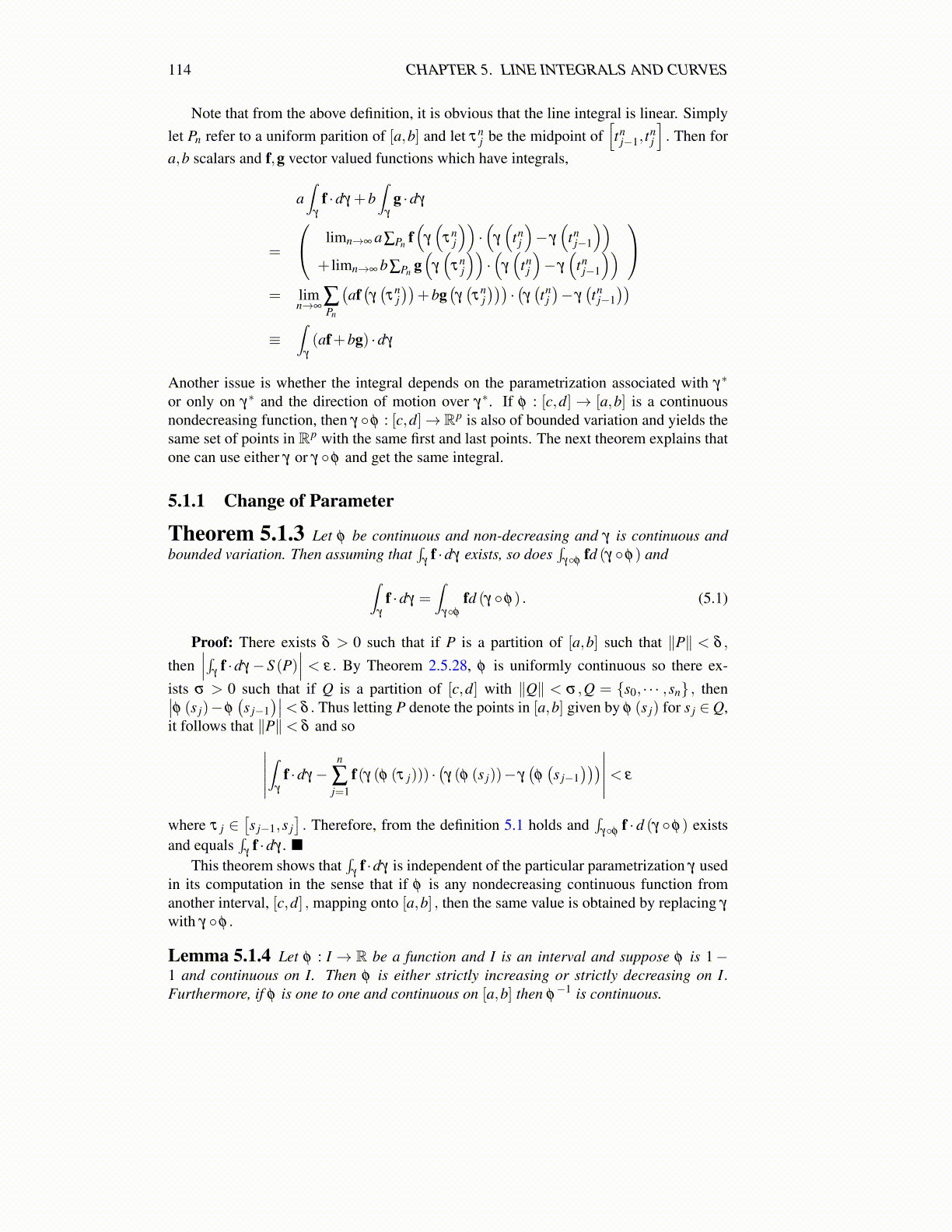
114 CHAPTER 5. LINE INTEGRALS AND CURVES
Note that from the above definition, it is obvious that the line integral is linear. Simplylet Pn refer to a uniform parition of [a,b] and let τn
j be the midpoint of[tn
j−1, tnj
]. Then for
a,b scalars and f,g vector valued functions which have integrals,
a∫
γ
f ·dγ +b∫
γ
g ·dγ
=
limn→∞ a∑Pn f(
γ
(τn
j
))·(
γ
(tn
j
)− γ
(tn
j−1
))+ limn→∞ b∑Pn g
(γ
(τn
j
))·(
γ
(tn
j
)− γ
(tn
j−1
)) = lim
n→∞∑Pn
(af(γ(τ
nj))
+bg(γ(τ
nj)))·(γ(tn
j)− γ(tn
j−1))
≡∫
γ
(af+bg) ·dγ
Another issue is whether the integral depends on the parametrization associated with γ∗
or only on γ∗ and the direction of motion over γ∗. If φ : [c,d]→ [a,b] is a continuousnondecreasing function, then γ ◦φ : [c,d]→ Rp is also of bounded variation and yields thesame set of points in Rp with the same first and last points. The next theorem explains thatone can use either γ or γ ◦φ and get the same integral.
5.1.1 Change of Parameter
Theorem 5.1.3 Let φ be continuous and non-decreasing and γ is continuous andbounded variation. Then assuming that
∫γ
f ·dγ exists, so does∫
γ◦φ fd (γ ◦φ) and∫γ
f ·dγ =∫
γ◦φfd (γ ◦φ) . (5.1)
Proof: There exists δ > 0 such that if P is a partition of [a,b] such that ∥P∥ < δ ,
then∣∣∣∫γ
f ·dγ−S (P)∣∣∣ < ε. By Theorem 2.5.28, φ is uniformly continuous so there ex-
ists σ > 0 such that if Q is a partition of [c,d] with ∥Q∥ < σ ,Q = {s0, · · · ,sn} , then∣∣φ (s j)−φ(s j−1
)∣∣< δ . Thus letting P denote the points in [a,b] given by φ (s j) for s j ∈Q,it follows that ∥P∥< δ and so∣∣∣∣∣
∫γ
f ·dγ−n
∑j=1
f(γ (φ (τ j))) ·(γ (φ (s j))− γ
(φ(s j−1
)))∣∣∣∣∣< ε
where τ j ∈[s j−1,s j
]. Therefore, from the definition 5.1 holds and
∫γ◦φ f · d (γ ◦φ) exists
and equals∫
γf ·dγ . ■
This theorem shows that∫
γf ·dγ is independent of the particular parametrization γ used
in its computation in the sense that if φ is any nondecreasing continuous function fromanother interval, [c,d] , mapping onto [a,b] , then the same value is obtained by replacing γ
with γ ◦φ .
Lemma 5.1.4 Let φ : I → R be a function and I is an interval and suppose φ is 1−1 and continuous on I. Then φ is either strictly increasing or strictly decreasing on I.Furthermore, if φ is one to one and continuous on [a,b] then φ
−1 is continuous.